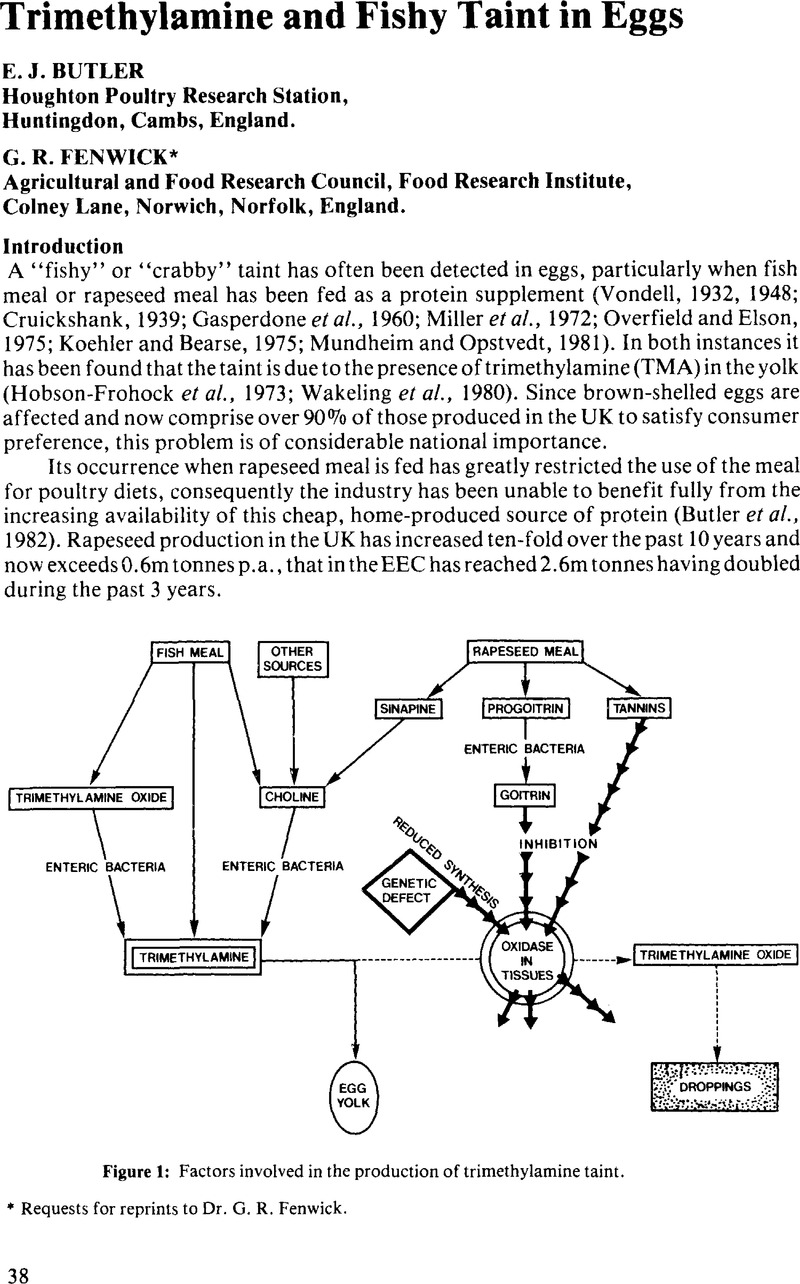Crossref Citations
This article has been cited by the following publications. This list is generated based on data provided by Crossref.
Fenwick, G.R
Butler, E.J
and
Brewster, M.A
1983.
ARE BRASSICA VEGETABLES AGGRAVATING FACTORS IN TRIMETHYLAMINURIA (FISH ODOUR SYNDROME)?.
The Lancet,
Vol. 322,
Issue. 8355,
p.
916.
King, MaryL
Bidwell, D
Voller, A
Bryant, Jennifer
and
Banatvala, J.E
1983.
ROLE OF COXSACKIE B VIRUSES IN INSULIN-DEPENDENT DIABETES MELLITUS.
The Lancet,
Vol. 322,
Issue. 8355,
p.
915.
Roger Fenwick, G.
Curl, Caralyn L.
Pearson, Arthur W.
and
Butler, Edward J.
1984.
The treatment of rapeseed meal and its effect on chemical composition and egg tainting potential.
Journal of the Science of Food and Agriculture,
Vol. 35,
Issue. 7,
p.
757.
Sones, Karen
Heaney, Robert K.
and
Fenwick, G. Roger
1984.
An estimate of the mean daily intake of glucosinolates from cruciferous vegetables in the UK.
Journal of the Science of Food and Agriculture,
Vol. 35,
Issue. 6,
p.
712.
Roger Fenwick, G.
Curl, Caralyn L.
Butler, Edward J.
Greenwood, Neil M.
and
Pearson, Arthur W.
1984.
Rapeseed meal and egg taint: Effects of low glucosinolate Brassica napus meal, dehulled meal and hulls, and of neomycin.
Journal of the Science of Food and Agriculture,
Vol. 35,
Issue. 7,
p.
749.
Martland, M.F.
Butler, E.J.
and
Fenwick, G.R.
1984.
Rapeseed induced liver haemorrhage, reticulolysis and biochemical changes in laying hens: the effects of feeding high and low glucosinolate meals.
Research in Veterinary Science,
Vol. 36,
Issue. 3,
p.
298.
Johnson, Ray J.
Brown, Nick
Eason, Paul
and
Sumner, John
1985.
The nutritional quality of two types of fish silage for broiler chickens.
Journal of the Science of Food and Agriculture,
Vol. 36,
Issue. 11,
p.
1051.
Abel, Hj.
Libal, R.
and
Icking, H.
1986.
Untersuchungen zum Einfluß von Cholin und Betain bei unterschiedlichem Methioningehalt des Legehennenfutters auf Parameter der Legeleistung und Futterverwertung.
Journal of Animal Physiology and Animal Nutrition,
Vol. 56,
Issue. 1-5,
p.
59.
Fenwick, G. Roger
Spinks, E. Ann
Wilkinson, Andrew P.
Heaney, Robert K.
and
Legoy, Maurice A.
1986.
Effect of processing on the antinutrient content of rapeseed.
Journal of the Science of Food and Agriculture,
Vol. 37,
Issue. 8,
p.
735.
WIGHT, P.A.L.
SHANNON, D.W.F.
McCORQUODALE, C.C.
and
SCOUGALL, R.K.
1987.
Experimental systems which modify and simulate rapeseed-induced liver haemorrhages in in-lay hens.
Research in Veterinary Science,
Vol. 43,
Issue. 3,
p.
351.
WIGHT, P.A.L.
SCOUGALL, R.K.
SHANNON, D.W.F.
WELLS, J.W.
and
MAWSON, R.
1987.
Role of glucosinolates in the causation of liver haemorrhages in laying hens fed water-extracted or heat-treated rapeseed cakes.
Research in Veterinary Science,
Vol. 43,
Issue. 3,
p.
313.
Dänicke, S.
Zachmann, R.
Böttcher, W.
and
Jeroch, H.
1995.
Einfluß gestaffelter Rapssaatanteile im Legehennenfutter auf das Fettsäurenmuster des Eifettes unter besonderer Berücksichtigung der polyungesättigten Fettsäuren.
Lipid / Fett,
Vol. 97,
Issue. 5,
p.
194.
Mawson, R.
Heaney, R. K.
Zdunczyk, Z.
and
Kozlowska, H.
1995.
Rapeseed meal‐Glucosinolates and their antinutritional effects Part 6. Taint in end‐products.
Food / Nahrung,
Vol. 39,
Issue. 1,
p.
21.
Saxby, M. J.
1996.
Food Taints and Off-Flavours.
p.
41.
Jensen, Mogens T.
Hansen, Laurits Lydehøj
and
Andersen, Henrik J.
2002.
Transfer of the Meat Aroma Precursors (Dimethyl Sulfide, Dimethyl Disulfide and Dimethyl Trisulfide) from Feed to Cooked Pork.
LWT - Food Science and Technology,
Vol. 35,
Issue. 6,
p.
485.
Krueger, Sharon K.
and
Williams, David E.
2005.
Mammalian flavin-containing monooxygenases: structure/function, genetic polymorphisms and role in drug metabolism.
Pharmacology & Therapeutics,
Vol. 106,
Issue. 3,
p.
357.
Dänicke, S ven
Ueberschär, Karl-Heinz
Reese, K ristina
and
Weigend, S teffen
2006.
Investigations on the effects of rape oil quality, choline and methionine concentration in diets for laying hens on the trimethylamine content of the eggs, on trimethylamine metabolism and on laying performance.
Archives of Animal Nutrition,
Vol. 60,
Issue. 1,
p.
57.
Kretzschmar, Katja
Reese, Kristina
Honkatukia, Mervi
Eding, H.
Preisinger, R.
Karl, H.
Dänicke, S.
and
Weigend, S.
2007.
Effect of Flavin containing monooxygenase (FMO3) genotype on trimethylamine (TMA) content in the chicken egg yolk.
European Poultry Science,
Vol. 71,
Issue. 5,
p.
200.
Lichovníková, M.
Zeman, L.
and
Jandásek, J.
2008.
The effect of feeding untreated rapeseed and iodine supplement on egg quality.
Czech Journal of Animal Science,
Vol. 53,
Issue. 2,
p.
77.
Jeroch, H.
Schöne, F.
and
Jankowski, J.
2008.
Inhaltsstoffe von Rapsfuttermitteln und Futterwert für das Geflügel.
European Poultry Science,
Vol. 72,
Issue. 1,
p.
8.



